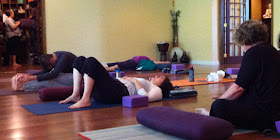Eye on Nature December 2012
On this winter day I find myself transfixed by a tree. Its leaves are gone, cut off by stem, shed by wind to the ground. Its bare branches are stark against the December gray as they reach toward a sun obscured by cloud.
The surface of this tree is rough and furrowed; it presses back against the flesh of my finger--solid. Yet the source of this rigid column, the weight of this tree, its very substance, comes magically out of thin air. Indeed, it is almost entirely made of carbon pulled from the byproducts of animal respiration and the release of gases from ancient plants burned as fuel.
The enormity of this idea stuns me, stops my forward progress, as I contemplate the reality that, through this tree, I can touch the breath of the past. It is alchemy—that this tree, through the process of photosynthesis, has taken something invisible, ethereal, and rearranged its chemistry to make solid form. Lead to Gold.
And this tree, standing silently before me, has done even more. It has gathered light and tied this energy to the molecular matrix of its cells. A branch of this tree sits in my fireplace at home. And when I place match to bark I will witness a miraculous transformation. From this tree I will feel, on a dark December night, the light and heat of a nearby star. Sequestered beneath layers of bark, contained within rings of growth, released as fire in my living room, the sun will shine again.
With an eye on nature,
Wally
Wally Shriner is an MHCC biology instructor and the Natural Resources Technology program faculty adviser. Eye on Nature is his monthly column. http://www.advocate-online.net/columnists/wallyshriner/
Happy New Year. May we all bring peace to ourselves and each other. Namaste, Sara







































